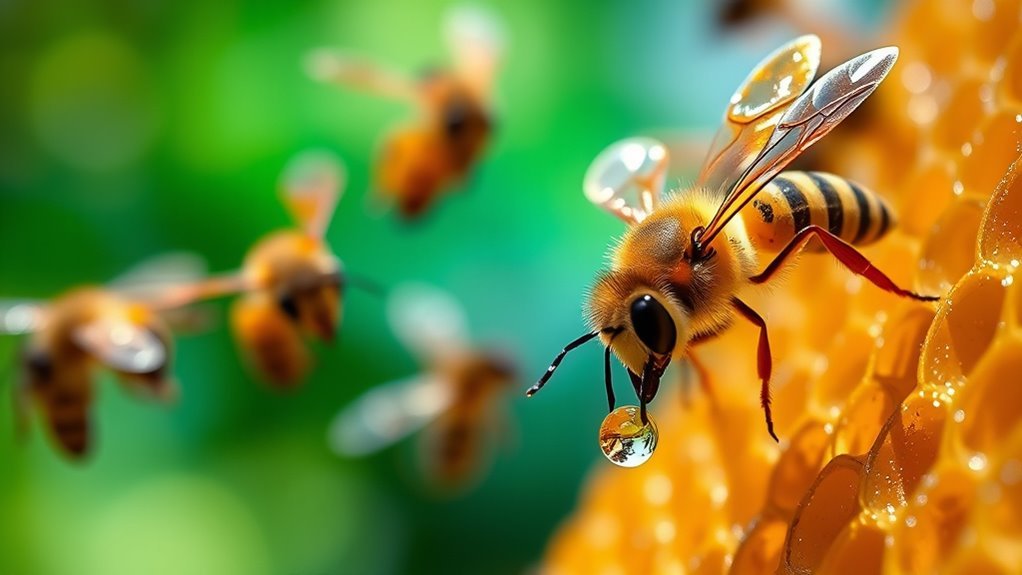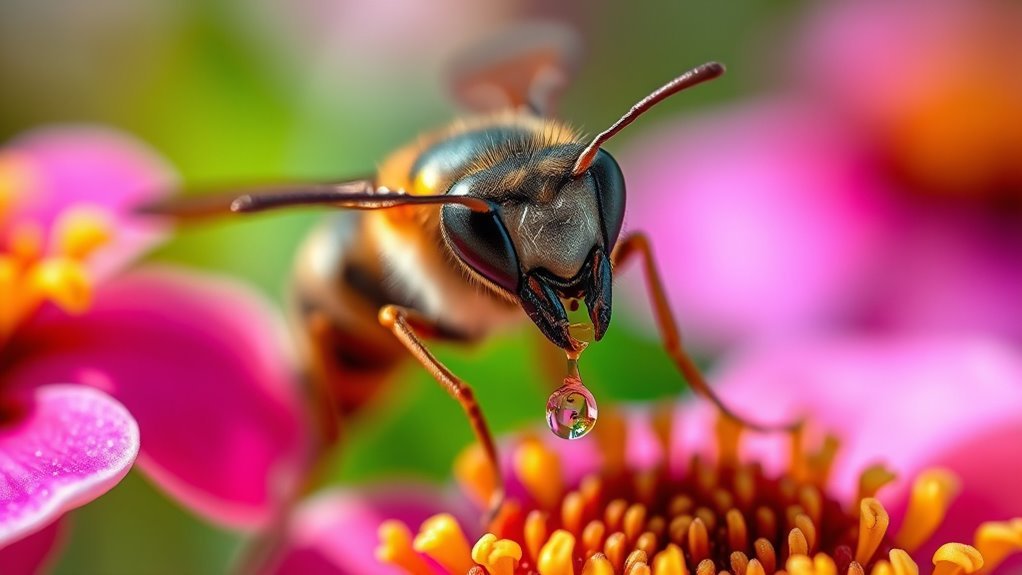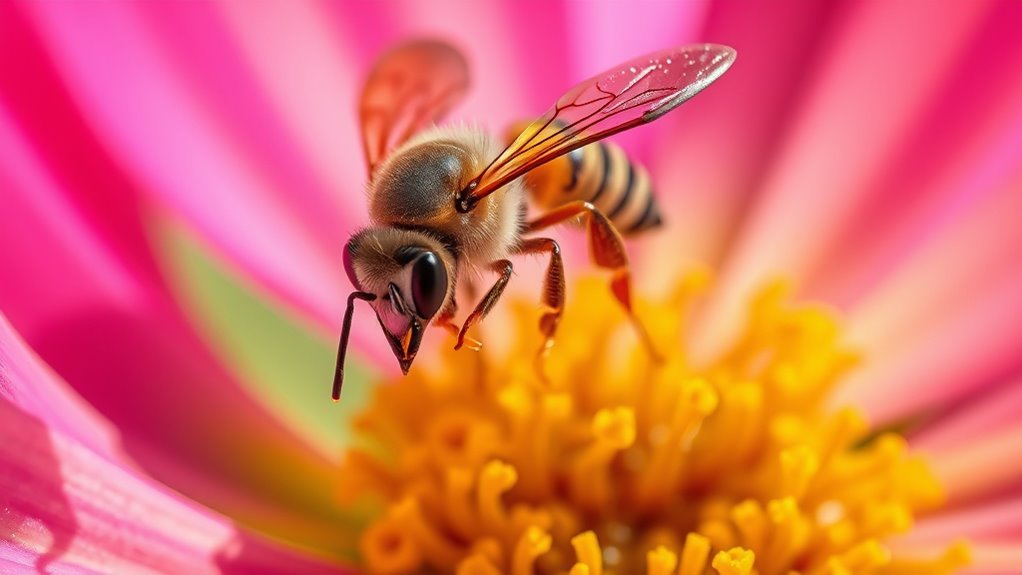Worker drones optimize their performance by consuming a balanced diet of nectar and pollen. Nectar provides essential carbohydrates for energy, while pollen supplies proteins and lipids necessary for growth and hive maintenance. Foraging strategies maximize nutrient intake, allowing drones to efficiently gather high-quality food. Their energy needs vary based on task complexity, emphasizing the importance of a diverse diet. Understanding these dynamics can enhance hive productivity and health, leading to more effective drone performances overall.
The Role of Worker Drones in the Hive

In a bee colony, worker drones play a crucial role, primarily focused on foraging, brood care, and hive maintenance. Within the drone hierarchy, these workers navigate complex hive dynamics, ensuring the colony’s survival and efficiency. They’re responsible for gathering nectar and pollen, which directly impacts the colony’s productivity. Additionally, they care for the larvae, contributing to the next generation of bees, and maintain the structural integrity of the hive. Their activities are synchronized with other workers, reflecting a collective effort that emphasizes the importance of communication and cooperation. Understanding the role of worker drones reveals how their contributions foster a robust hive environment, ultimately supporting the colony’s autonomy and resilience against external threats.
Nutritional Requirements of Worker Drones

Worker drones require a balanced diet to sustain their demanding roles in the hive, with specific nutritional components crucial for peak performance. Key elements include adequate protein sources and maintaining energy balance.
| Nutrient | Function | Sources |
|---|---|---|
| Protein | Muscle repair and growth | Pollen, nectar |
| Carbohydrates | Energy supply | Nectar |
| Lipids | Cell membrane integrity | Beeswax, oils |
To support their tasks, worker drones need a consistent intake of these macronutrients. Protein sources play an essential role in their physical capabilities, while carbohydrates offer the necessary energy for daily activities. Striking this balance guarantees maximum efficiency within the hive, empowering their freedom to perform crucial functions.
Sources of Food: Nectar and Pollen

Although worker drones depend heavily on nectar and pollen, the specific roles these food sources play in their nutritional regimen are distinct and fundamental. Nectar sources, primarily derived from flowering plants, provide carbohydrates essential for energy, enabling drones to perform tasks efficiently. In contrast, pollen types offer proteins and lipids critical for growth and development. The diversity of nectar sources and pollen types guarantees a balanced intake, enhancing resilience and productivity. Worker drones utilize these food sources strategically, adapting their foraging behavior based on availability and nutritional needs. By prioritizing high-quality nectar and diverse pollen, they optimize energy levels and overall performance, ultimately contributing to the colony’s success. Understanding these dynamics is key to appreciating their foraging strategies.
The Process of Foraging
Foraging is a complex process that requires worker drones to employ sophisticated strategies to locate and collect food efficiently. You’ll find that drones utilize various foraging techniques, including food scouting, to maximize their productivity. These techniques involve systematic exploration and communication with other drones, guaranteeing effective navigation and resource identification.
| Foraging Technique | Description |
|---|---|
| Food Scouting | Drones search for food sources, mapping areas with abundant resources. |
| Communication | Sharing information about food locations enhances group efficiency. |
| Resource Evaluation | Evaluating food quality guarantees drones prioritize nutrient-rich options. |
How Drones Consume Food
Understanding how drones consume food requires an analysis of their energy sources and nutritional requirements. You’ll find that the efficiency of their energy intake directly impacts their performance and productivity. By examining these factors, you can gain insights into optimizing drone operations for enhanced functionality.
Energy Sources Explained
As worker drones navigate their environments in search of sustenance, they rely on a complex system of energy conversion that is vital for maintaining ideal performance. The efficiency with which they convert food into usable energy directly impacts their metabolic efficiency. Understanding these energy sources is significant for optimizing functionality.
| Energy Source | Conversion Efficiency |
|---|---|
| Carbohydrates | High |
| Fats | Moderate |
| Proteins | Low |
| Synthetic Nutrients | Variable |
| Environmental Sources | High |
Nutritional Requirements Defined
While traversing their environments, worker drones must meet specific nutritional requirements to optimize their performance and energy conversion. To achieve this, they rely on a carefully balanced intake of carbohydrates, proteins, and fats, which facilitate efficient nutrient absorption. The quality and composition of these nutrients directly influence metabolic efficiency, enabling drones to convert food into usable energy effectively.
The Importance of Royal Jelly
Royal jelly, a nutrient-rich secretion produced by nurse bees, plays a crucial role in the development and health of bee colonies. This substance is essential for the nutrition of larvae, particularly those destined to become queens. Its unique composition, rich in proteins, vitamins, and lipids, directly influences hive health, ensuring robust growth and development. Worker drones consume royal jelly in their formative stages, benefiting from its growth-promoting properties. By supporting the development of healthy queens, royal jelly indirectly sustains the entire colony’s productivity and longevity. As you explore the significance of royal jelly, consider its critical role in maintaining hive health and optimizing the performance of worker drones, ultimately contributing to the resilience of the entire bee ecosystem.
Energy Needs for Different Tasks
When evaluating energy needs, you must consider the specific nutritional requirements for different tasks worker drones perform. Each activity demands distinct energy sources and utilization rates, which can considerably influence overall performance. Additionally, varying activity levels directly impact energy consumption, necessitating a tailored approach to dietary intake.
Task-specific Nutritional Requirements
Understanding the task-specific nutritional requirements for worker drones is essential, as their energy needs vary considerably based on the complexity and duration of the tasks at hand. Optimizing nutrient absorption through dietary variations can enhance performance. Here are some key considerations:
- Short tasks: Require quick energy sources, like simple carbohydrates, for immediate fuel.
- Extended tasks: Demand sustained energy from complex carbohydrates and healthy fats for endurance.
- Cognitive tasks: Benefit from omega-3 fatty acids and antioxidants to support brain function.
- Physical labor: Necessitate higher protein intake for muscle repair and recovery.
Energy Sources and Utilization
Worker drones’ energy needs vary considerably based on the tasks they undertake, influencing the types of energy sources they utilize. For instance, tasks requiring sustained endurance demand a higher reliance on carbohydrates, while short bursts of high-intensity activities might shift energy metabolism towards fats. Your food preferences play a critical role here; choosing energy-dense options can optimize performance for specific tasks. The efficiency of energy utilization directly correlates with how well you align your intake with your workload. Understanding these dynamics allows you to tailor your nutrition, ensuring you maintain peak performance while enjoying the freedom of choice in your dietary selections. Ultimately, strategic energy management can enhance your productivity and overall effectiveness in various tasks.
Impact of Activity Levels
While activity levels markedly influence energy requirements, the specific demands of various tasks dictate how those energy needs manifest. Understanding this impact is vital for optimizing performance metrics among worker drones. Consider the following aspects:
- Metabolic rates: Higher activity levels increase energy expenditure, necessitating a richer nutritional balance.
- Task allocation: Different roles, like foraging or hive maintenance, affect energy demands and worker fatigue.
- Seasonal variations: Energy needs fluctuate based on environmental conditions and available resources.
- Foraging efficiency: Effective foraging strategies enhance nutritional intake, aligning with hive dynamics and ensuring peak performance.
Impact of Nutrition on Hive Productivity
The nutritional quality of the food available to bees greatly influences hive productivity, as it directly affects their health, behavior, and efficiency in foraging. When you focus on nutrition optimization, you’re ensuring that worker drones receive a balanced diet rich in carbohydrates, proteins, and essential vitamins. This balance not only supports their energy needs but also enhances hive efficiency by improving communication and coordination among the bees. Adequate nutrition can reduce stress levels and increase resilience against diseases, directly correlating to the colony’s overall productivity. As a beekeeper, understanding the impact of nutrition on your hive helps you create an environment where worker drones can thrive, ultimately leading to increased honey yields and healthier colonies.
Strategies for Enhancing Drone Nutrition
To enhance drone nutrition effectively, beekeepers should implement targeted strategies that guarantee a diverse and nutrient-rich food supply. By focusing on specific practices, you can optimize drone health and performance. Consider the following strategies:
Implementing targeted strategies ensures a diverse, nutrient-rich food supply, optimizing drone health and hive performance.
- Incorporate dietary supplements: Use pollen patties or sugar syrup enriched with vitamins and minerals.
- Optimize food storage: Confirm that stored food is free from contaminants and maintains freshness to prevent spoilage.
- Monitor food availability: Regularly assess hive resources to confirm drones have access to adequate nutrition throughout the season.
- Diversify forage sources: Plant a variety of flowers to provide a broad spectrum of nutrients, supporting overall hive strength.
These strategies not only enhance drone nutrition but also promote hive resilience and productivity.
Frequently Asked Questions
Can Worker Drones Consume Food From Other Hives?
You’ll find worker drones typically don’t consume food from other hives due to hive competition. However, food sharing within their own hive promotes efficiency, enhancing overall productivity and maintaining a cooperative social structure.
How Do Environmental Factors Affect Drone Nutrition?
Imagine a world where nutrient availability is scarce; climate impact directly influences drone nutrition. If environmental conditions shift, it can drastically alter food sources, ultimately affecting your drones’ health and productivity. Adaptation is essential for survival.
What Role Do Enzymes Play in Drone Digestion?
Enzymes enhance digestive efficiency by catalyzing biochemical reactions. You’ll find that increased enzyme activity accelerates nutrient breakdown, ensuring worker drones absorb essential components swiftly, ultimately supporting their energy needs and operational effectiveness in various environments.
Do Worker Drones Have Taste Preferences for Certain Foods?
Imagine drones with gourmet palates, craving specific food types! Worker preferences can indeed influence their efficiency, as certain nutrients boost energy levels. Understanding these taste inclinations is essential for optimizing their performance and overall well-being.
How Does Age Influence a Drone’s Eating Habits?
As drones age, their metabolism changes, affecting nutritional needs. Younger drones require energy-dense foods for growth, while older ones benefit from balanced diets that maintain efficiency, ensuring they adapt to their evolving performance requirements effectively.

